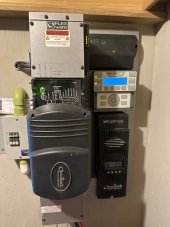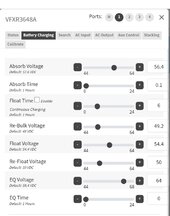The EG4's should work just fine BUT only in a Manual Settings mode in the EG4 and in the Outback components, meaning, you cannot connect the EG4's by communication cable, to communicate any settings or data with the Outback Inverter nor the Outback FlexMax charge controller, nor is communication between components really needed. I run my components and 2 batteries without shared communication and everything runs just fine. Communication can be helpful IF the components are built for it to be shared properly. The Outback components are not built to be shared with EG4's and the opposite. There are no real drawbacks using the EG4's with the Outback components. Data enthusiasts like the more modern components to share settings and data but it can also be overwhelming to try to tweak performance. It depends on your OCD or how your brain works or is stimulated if you desire shared data and desire for complexity and troubleshooting of communication and of your budget, as newer components for shared data will cost you and you will lose value on the perfectly fine and quality Outback components.
You should read the user manual for the Inverter/Charger for instructions on how to set up the generator Charging Voltage High and Low Set Points. Same with the FlexMax Charge Controller. I have used the FlexMax 80 with Lithium Batteries and it works fine, nothing special as a manual charge controller. You will have to learn how to set the generator charger set points to a controlled C Rate or Charge Rate and to set the voltages to play nice with your EG4 BMS over and under voltage set points.
Charging slowly is better than charging really fast, as LiFePO4 suffers and can degrade with heat and charging always creates heat. Fast charging creates more heat than slower charging. So depending on the C Rate (Charge / Discharge Rates) recommendations of your EG4's in the EG4 user manual, that should help.
The EG4 user manual should give you Charge Voltage Set Points. The battery manufacturers all provide this information, not the component manufacturers. However, these "recommendations" are just that and for the impatient general public that want set it and forget it settings for fast performance but which causes longer term battery life to suffer. However, the LiFePO4 technology is still to new for anyone to know 100% what the best charge voltage settings are.
If you search and read the forums, LiFePO4 batteries CAN cycle from 100%-0% but it is NOT RECOMMENDED to be a normal charge and discharge cycle, unless long term battery life is not a consideration. Charge to discharge settings of 90%-10% is discussed as a better target for daily use. However, cycling between 90-10% or any percentages is often difficult to manage, unless one turns off the solar panels or whatever charging source (generator, turbine) manually every day. As most people have extra solar panel watts over their battery capacity and so either rarely draw down the batteries much and so charge to nearly 100% every day because they can't use all the power created by the solar panels on a sunny day. My batteries rarely go below 80% SOC (State of Charge) each day because I simply do not run enough appliances to use all the power created by my solar panels ON A SUNNY DAY. So I set my FlexMax Solar Charge Controller (SCC) Bulk, Absorption and Float settings lower to avoid maximum charged voltages, often as suggested by Battery Manufacturers in their specs or user manuals, eg: Charged or Bulk / Absorption Voltage Set point to be 3.65V per cell (29.2-29.6 for 24V system or 58.4+ Volts for 48V battery bank). These charge fast, but create heat and LiFePO4 batteries don't like heat nor to be at a 100% State of Charge (SOC) for long periods of time.
Do a forum search for LiFePO4 Charge settings, as there are MANY MANY MANY threads on this and quite a few opinions on the best settings, for best performance or best battery life. These Outback components were built before LiFePO4 technology, so their user manuals do not have LiFePO4 settings info. But the components don't really care where the electrons come from, such as Lead Acid, AGM vs LiFePO4 batteries or even liquid fuel generators. The Settings for LiFePO4 are to safeguard the battery for over or under charging and for general use and long term battery life. LiFePO4 is also relatively new so no one really knows 100% what THE BEST charge and discharge settings are, as every setting has compromises. The settings must also be compatible with settings in the EG4 BMS, which your EG4 user manual should discuss, or contact the EG4 seller for how to set up the BMS and the Outback voltage charge and discharge settings for either or best / fast performance or long term battery life or a compromise of the 2.
You can also search YouTube for lots of videos, such as Off Grid Garage, or Will Prowse videos for basics and info on Charger Voltage settings for your LiFePO4 battery types.
 Trying to pair this older 3.5 kW inverter (~10 years old) with three EG4 batteries. Outback rep said it should work fine; website says it’s not compatible with lithium. A few questions for the pros:
Trying to pair this older 3.5 kW inverter (~10 years old) with three EG4 batteries. Outback rep said it should work fine; website says it’s not compatible with lithium. A few questions for the pros:



